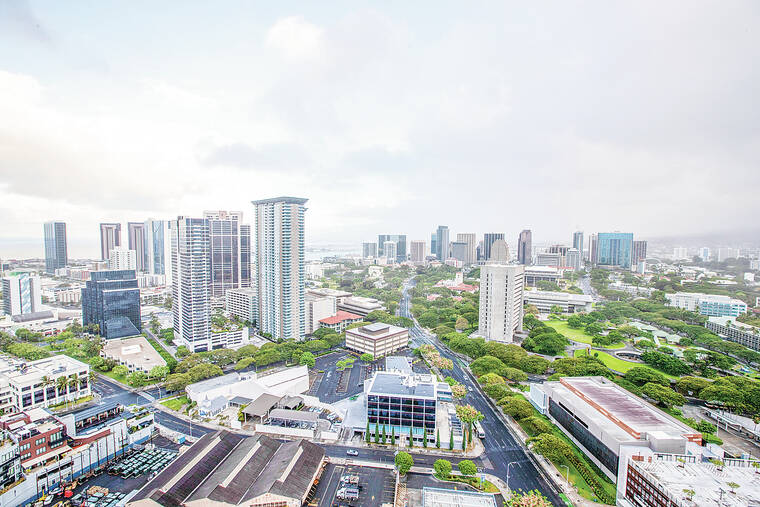Hawaiian Electric avoided a second straight evening of rolling blackouts across Oahu on Tuesday, but the power shutoffs Monday substantiated prior concerns about the company’s shift to more renewable energy.
Over the past few years, Hawaii government officials have warned about possible electricity shortages occurring in the wake of decommissioning a big coal-fired power plant as planned solar farm and battery storage projects faced delays or cancellation.
Before the 180-megawatt coal plant at Campbell Industrial Park operated by AES Corp. was shut down in September 2022, Hawaiian Electric officials expressed high confidence that enough excess power generation capacity could meet demand even with renewable-energy project setbacks.
“I think we’re in a good place to be able to keep the lights on and continue to serve load reliably from our generation systems even if some of those (new power sources) were not to happen or were to be delayed,” Colton Ching, Hawaiian Electric senior vice president of planning and technology, said during a June 2021 state Public Utilities Commission briefing.
Hawaiian Electric described Monday’s shortage as largely the result of several impacts from a Kona storm that brought heavy rain and strong wind from the south.
The company said two of six generation units at its Waiau Power Plant in Pearl City were knocked offline Monday afternoon by the storm, with one unit getting flooded and one unit losing its transmission line to the grid. The two units combined have a 100-megawatt production capacity at the 500-megawatt plant.
Meanwhile, Monday’s stormy weather reduced the amount of solar energy being generated and stored in battery systems for release during the peak evening usage period.
“They didn’t have the full charge available to help us through the night,” said Darren Pai, a Hawaiian Electric spokesperson.
Other factors contributing to the blackouts included a slowing of wind power generation during Monday evening and some reduced generation by the city’s HPOWER garbage-to-energy plant, according to the utility company.
In all, the Waiau generation, solar, batteries, wind and HPOWER produced five factors affecting the shortage.
As a result, about 120,000 customers in more than two dozen communities throughout Central, Leeward, East and Windward Oahu had their power purposely cut off for up to roughly 30-minute periods that began shortly before 8 p.m. and rotated around the island until shortly after 10 p.m.
Hawaiian Electric on Monday afternoon had publicly announced that the rolling blackouts, or what it also calls “load shedding,” could run from 5:30 to 11 p.m. and asked customers to conserve electricity.
On Tuesday, state Sen. Glenn Wakai, vice chair of the Senate Committee on Energy, Economic Development and Tourism, said Monday’s shortfall shows that closure of the coal plant, which once supplied around 15% of peak electricity use, was premature and left an insufficient safety net of reserve generation capacity.
“Senators have been clamoring to put more firm renewables on the grid,” said Wakai (D, Kalihi-Salt Lake-Pearl Harbor). “The recent rains showed us solar, wind and batteries are incapable of ensuring we have a reliable grid.”
The utility company in recent years carefully avoided guaranteeing to regulators that no power supply shortages would happen given the unpredictability of events.
Yet it’s easy to see how Monday’s shortage might not have happened or been as big if some of the delayed or canceled solar farm and battery storage projects had been operating, and also how it could have been worse if one project had not come online since the coal plant shutdown.
Just three weeks ago a battery storage system capable of storing 565 megawatt -hours of energy, Kapolei Energy Storage, began commercial operation after a more than one-year delay.
December also was supposed to be when a 120-megawatt solar farm with 420 megawatt-hours of storage called Mahi Solar was projected to come online in Kunia. But this project with a capacity to power about 37,000 homes got canceled after delays.
Another Oahu solar farm project, Kupehau Solar, that was half as big as Mahi Solar and once expected to begin operating in 2023, also got canceled.
Two other solar farms with battery systems had been previously expected to go into service on Oahu in 2023 but have been delayed to later this year. One is Ho ohana Solar, with 52 megawatts of generation capacity and 208 megawatt-hours of battery storage. The other is Waiawa Phase 2 Solar, with 30 megawatts of generation capacity and 240 megawatt-hours of battery storage.
Issues with the troubled projects have included supply chain setbacks during the coronavirus pandemic, rising costs and other things.






